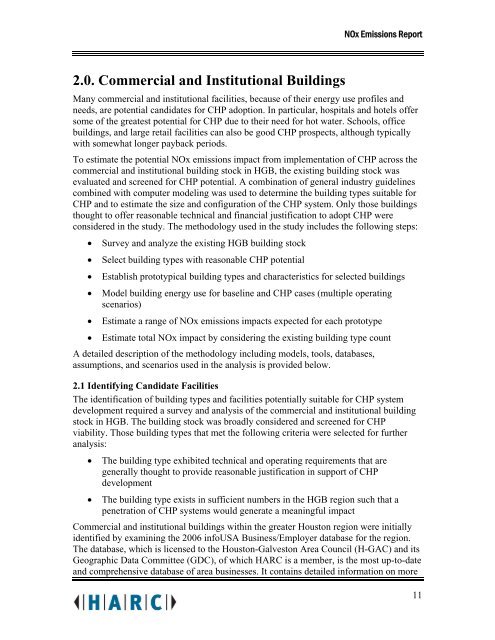NOx Emissions Impacts from Widespread Deployment of CHP in ...
NOx Emissions Impacts from Widespread Deployment of CHP in ...
NOx Emissions Impacts from Widespread Deployment of CHP in ...
You also want an ePaper? Increase the reach of your titles
YUMPU automatically turns print PDFs into web optimized ePapers that Google loves.
2.0. Commercial and Institutional Build<strong>in</strong>gs<br />
<strong>NOx</strong> <strong>Emissions</strong> Report<br />
Many commercial and <strong>in</strong>stitutional facilities, because <strong>of</strong> their energy use pr<strong>of</strong>iles and<br />
needs, are potential candidates for <strong>CHP</strong> adoption. In particular, hospitals and hotels <strong>of</strong>fer<br />
some <strong>of</strong> the greatest potential for <strong>CHP</strong> due to their need for hot water. Schools, <strong>of</strong>fice<br />
build<strong>in</strong>gs, and large retail facilities can also be good <strong>CHP</strong> prospects, although typically<br />
with somewhat longer payback periods.<br />
To estimate the potential <strong>NOx</strong> emissions impact <strong>from</strong> implementation <strong>of</strong> <strong>CHP</strong> across the<br />
commercial and <strong>in</strong>stitutional build<strong>in</strong>g stock <strong>in</strong> HGB, the exist<strong>in</strong>g build<strong>in</strong>g stock was<br />
evaluated and screened for <strong>CHP</strong> potential. A comb<strong>in</strong>ation <strong>of</strong> general <strong>in</strong>dustry guidel<strong>in</strong>es<br />
comb<strong>in</strong>ed with computer model<strong>in</strong>g was used to determ<strong>in</strong>e the build<strong>in</strong>g types suitable for<br />
<strong>CHP</strong> and to estimate the size and configuration <strong>of</strong> the <strong>CHP</strong> system. Only those build<strong>in</strong>gs<br />
thought to <strong>of</strong>fer reasonable technical and f<strong>in</strong>ancial justification to adopt <strong>CHP</strong> were<br />
considered <strong>in</strong> the study. The methodology used <strong>in</strong> the study <strong>in</strong>cludes the follow<strong>in</strong>g steps:<br />
• Survey and analyze the exist<strong>in</strong>g HGB build<strong>in</strong>g stock<br />
• Select build<strong>in</strong>g types with reasonable <strong>CHP</strong> potential<br />
• Establish prototypical build<strong>in</strong>g types and characteristics for selected build<strong>in</strong>gs<br />
• Model build<strong>in</strong>g energy use for basel<strong>in</strong>e and <strong>CHP</strong> cases (multiple operat<strong>in</strong>g<br />
scenarios)<br />
• Estimate a range <strong>of</strong> <strong>NOx</strong> emissions impacts expected for each prototype<br />
• Estimate total <strong>NOx</strong> impact by consider<strong>in</strong>g the exist<strong>in</strong>g build<strong>in</strong>g type count<br />
A detailed description <strong>of</strong> the methodology <strong>in</strong>clud<strong>in</strong>g models, tools, databases,<br />
assumptions, and scenarios used <strong>in</strong> the analysis is provided below.<br />
2.1 Identify<strong>in</strong>g Candidate Facilities<br />
The identification <strong>of</strong> build<strong>in</strong>g types and facilities potentially suitable for <strong>CHP</strong> system<br />
development required a survey and analysis <strong>of</strong> the commercial and <strong>in</strong>stitutional build<strong>in</strong>g<br />
stock <strong>in</strong> HGB. The build<strong>in</strong>g stock was broadly considered and screened for <strong>CHP</strong><br />
viability. Those build<strong>in</strong>g types that met the follow<strong>in</strong>g criteria were selected for further<br />
analysis:<br />
• The build<strong>in</strong>g type exhibited technical and operat<strong>in</strong>g requirements that are<br />
generally thought to provide reasonable justification <strong>in</strong> support <strong>of</strong> <strong>CHP</strong><br />
development<br />
• The build<strong>in</strong>g type exists <strong>in</strong> sufficient numbers <strong>in</strong> the HGB region such that a<br />
penetration <strong>of</strong> <strong>CHP</strong> systems would generate a mean<strong>in</strong>gful impact<br />
Commercial and <strong>in</strong>stitutional build<strong>in</strong>gs with<strong>in</strong> the greater Houston region were <strong>in</strong>itially<br />
identified by exam<strong>in</strong><strong>in</strong>g the 2006 <strong>in</strong>foUSA Bus<strong>in</strong>ess/Employer database for the region.<br />
The database, which is licensed to the Houston-Galveston Area Council (H-GAC) and its<br />
Geographic Data Committee (GDC), <strong>of</strong> which HARC is a member, is the most up-to-date<br />
and comprehensive database <strong>of</strong> area bus<strong>in</strong>esses. It conta<strong>in</strong>s detailed <strong>in</strong>formation on more<br />
11
















